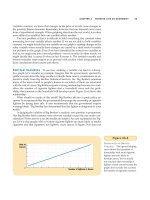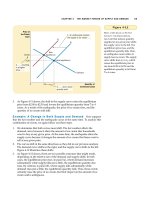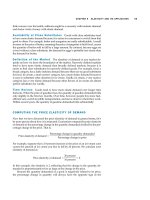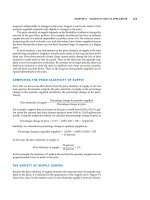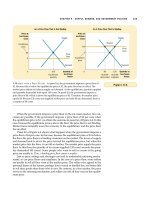Tài liệu Ten Principles of Economics - Part 34 docx
Bạn đang xem bản rút gọn của tài liệu. Xem và tải ngay bản đầy đủ của tài liệu tại đây (222.23 KB, 10 trang )
CHAPTER 15 MONOPOLY 341
probably be arrested for price-fixing if
they ever held an official meeting in
America.
Most cable TV companies have
government-issued licenses that keep
competitors out. Thus, this business
supports the hypothesis (offered, I think,
by George Stigler) that private monopo-
lies are not sustainable for long unless
they have the weight of government be-
hind them.
The rapid escalation of prices and
the limitations on services seem, how-
ever, to be getting customers and their
congressional representatives progres-
sively more annoyed. Thus, it would not
be surprising if legislative action leads
soon to a deterioration of the cable com-
panies’ monopoly power. . . . This fear
about the future diminishes the claim of
this otherwise worthy contestant for the
first annual prize.
Officials of Ivy League universities
have been able to meet in semi-public fo-
rums to set rules that determine prices
of admission (tuition less financial aid) as
a function of applicant characteristics,
especially financial resources. In some
cases, the schools pooled information to
agree in advance on the right price to
charge a specific customer. Airlines and
other industries that wish to price dis-
criminate can only dream about this kind
of setup.
Moreover, the universities have
more or less successfully applied a high
moral tone to the process: Rich appli-
cants—especially smart rich applicants—
are charged more than the competitive
price for schooling in order to subsidize
the smart poor, but it is unclear why this
subsidy should come from the smart rich
rather than from taxpayers in general.
In any event, the universities’ envi-
able cartel position has been damaged
by the unenlightened Justice Depart-
ment, which argued that the price-setting
meetings were a violation of antitrust
laws. Since most of the universities in-
volved have agreed to stop these prac-
tices, it may be that future prices for
private higher education will come closer
to being competitively determined. . . .
The final contestant, the NCAA, has
been remarkably successful in holding
down “salaries” paid to college athletes.
It would be one thing merely to collude
to determine price ceilings (for example,
to restrict payments so that they not ex-
ceed tuition plus room and board and
some minor additional amount), but the
NCAA has also managed to monopolize
all the moral arguments.
Consider a poor ghetto resident
who can play basketball well, but not well
enough to make it to the NBA. If there
were no NCAA, this player might be able
legitimately to accumulate a significant
amount of cash during a four-year career.
But the NCAA ensures that the player
will remain poor after four years and,
moreover, has convinced most ob-
servers that it would be morally wrong
for the college to pay the player a com-
petitively determined wage for his or her
services.
For many economists, this interfer-
ence with competition—in a setting that
has no obvious reasons for market fail-
ure—is itself morally repugnant. But the
outrage is compounded here because
the transfer is clearly from poor ghetto
residents to rich colleges. Compare the
situation of contestant number 4, the Ivy
League universities, in which the transfer
from rich to poor students can readily be
supported on Robin Hood grounds.
The NCAA has the much more diffi-
cult task of defending a policy that pre-
vents many poor individuals from earning
money. Incredibly, this defense has been
so successful that it has even allowed
the organization to maintain the moral
high ground. When the NCAA maintains
its cartel by punishing schools that violate
the rules (by paying too much), almost no
one doubts that the evil entities are the
schools or people who paid the athletes,
rather than the cartel enforcers who pre-
vented the athletes from getting paid.
Given this extraordinary balancing act,
the decision of the panelists was straight-
forward and the NCAA is the clear and
deserving winner of the first annual prize
for best monopoly in America.
The panel of economists also con-
sidered briefly an award for the least effi-
cient monopoly in America. This choice
was, however, too easy. It goes to the
American Economic Association, which
has been a dismal failure at establishing
licensing requirements or other restric-
tions on entry into the economics pro-
fession. It is a sad state of affairs when
almost anyone can assume the title of
economist.
SOURCE: The Wall Street Journal, August 27, 1991,
p. A12.
342 PART FIVE FIRM BEHAVIOR AND THE ORGANIZATION OF INDUSTRY
willingness to pay for a ticket. In this case, movie theaters raise their profit by price
discriminating.
Airline Prices Seats on airplanes are sold at many different prices. Most air-
lines charge a lower price for a round-trip ticket between two cities if the traveler
stays over a Saturday night. At first this seems odd. Why should it matter to the
airline whether a passenger stays over a Saturday night? The reason is that this
rule provides a way to separate business travelers and personal travelers. A pas-
senger on a business trip has a high willingness to pay and, most likely, does not
want to stay over a Saturday night. By contrast, a passenger traveling for personal
reasons has a lower willingness to pay and is more likely to be willing to stay over
a Saturday night. Thus, the airlines can successfully price discriminate by charging
a lower price for passengers who stay over a Saturday night.
Discount Coupons Many companies offer discount coupons to the public
in newspapers and magazines. A buyer simply has to clip out the coupon in order
to get $0.50 off his next purchase. Why do companies offer these coupons? Why
don’t they just cut the price of the product by $0.50?
The answer is that coupons allow companies to price discriminate. Companies
know that not all customers are willing to spend the time to clip out coupons.
Moreover, the willingness to clip coupons is related to the customer’s willingness
to pay for the good. A rich and busy executive is unlikely to spend her time clip-
ping discount coupons out of the newspaper, and she is probably willing to pay a
higher price for many goods. A person who is unemployed is more likely to clip
coupons and has a lower willingness to pay. Thus, by charging a lower price only
to those customers who clip coupons, firms can successfully price discriminate.
Financial Aid Many colleges and universities give financial aid to needy
students. One can view this policy as a type of price discrimination. Wealthy stu-
dents have greater financial resources and, therefore, a higher willingness to pay
than needy students. By charging high tuition and selectively offering financial
aid, schools in effect charge prices to customers based on the value they place on
going to that school. This behavior is similar to that of any price-discriminating
monopolist.
Quantity Discounts So far in our examples of price discrimination, the
monopolist charges different prices to different customers. Sometimes, however,
monopolists price discriminate by charging different prices to the same customer
for different units that the customer buys. For example, many firms offer lower
prices to customers who buy large quantities. A bakery might charge $0.50 for each
donut, but $5 for a dozen. This is a form of price discrimination because the
customer pays a higher price for the first unit bought than for the twelfth. Quan-
tity discounts are often a successful way of price discriminating because a cus-
tomer’s willingness to pay for an additional unit declines as the customer buys
more units.
QUICK QUIZ: Give two examples of price discrimination. ◆ How does
perfect price discrimination affect consumer surplus, producer surplus, and
total surplus?
CHAPTER 15 MONOPOLY 343
CONCLUSION: THE PREVALENCE OF MONOPOLY
This chapter has discussed the behavior of firms that have control over the prices
they charge. We have seen that because monopolists produce less than the socially
efficient quantity and charge prices above marginal cost, they cause deadweight
losses. These inefficiencies can be mitigated through prudent public policies or, in
some cases, through price discrimination by the monopolist.
How prevalent are the problems of monopoly? There are two answers to this
question.
In one sense, monopolies are common. Most firms have some control over the
prices they charge. They are not forced to charge the market price for their goods,
because their goods are not exactly the same as those offered by other firms. A
Ford Taurus is not the same as a Toyota Camry. Ben and Jerry’s ice cream is not the
same as Breyer’s. Each of these goods has a downward-sloping demand curve,
which gives each producer some degree of monopoly power.
Yet firms with substantial monopoly power are quite rare. Few goods are truly
unique. Most have substitutes that, even if not exactly the same, are very similar.
Ben and Jerry can raise the price of their ice cream a little without losing all their
sales; but if they raise it very much, sales will fall substantially.
In the end, monopoly power is a matter of degree. It is true that many firms
have some monopoly power. It is also true that their monopoly power is usually
quite limited. In these cases, we will not go far wrong assuming that firms operate
in competitive markets, even if that is not precisely the case.
◆ A monopoly is a firm that is the sole seller in its market.
A monopoly arises when a single firm owns a key
resource, when the government gives a firm the exclusive
right to produce a good, or when a single firm can supply
the entire market at a smaller cost than many firms could.
◆ Because a monopoly is the sole producer in its market, it
faces a downward-sloping demand curve for its
product. When a monopoly increases production by 1
unit, it causes the price of its good to fall, which reduces
the amount of revenue earned on all units produced. As
a result, a monopoly’s marginal revenue is always
below the price of its good.
◆ Like a competitive firm, a monopoly firm maximizes
profit by producing the quantity at which marginal
revenue equals marginal cost. The monopoly then
chooses the price at which that quantity is demanded.
Unlike a competitive firm, a monopoly firm’s price
exceeds its marginal revenue, so its price exceeds
marginal cost.
◆ A monopolist’s profit-maximizing level of output is
below the level that maximizes the sum of consumer
and producer surplus. That is, when the monopoly
charges a price above marginal cost, some consumers
who value the good more than its cost of production do
not buy it. As a result, monopoly causes deadweight
losses similar to the deadweight losses caused by taxes.
◆ Policymakers can respond to the inefficiency of
monopoly behavior in four ways. They can use the
antitrust laws to try to make the industry more
competitive. They can regulate the prices that the
monopoly charges. They can turn the monopolist into a
government-run enterprise. Or, if the market failure is
deemed small compared to the inevitable imperfections
of policies, they can do nothing at all.
◆ Monopolists often can raise their profits by charging
different prices for the same good based on a buyer’s
willingness to pay. This practice of price discrimination
can raise economic welfare by getting the good to some
Summary
344 PART FIVE FIRM BEHAVIOR AND THE ORGANIZATION OF INDUSTRY
consumers who otherwise would not buy it. In the
extreme case of perfect price discrimination, the
deadweight losses of monopoly are completely
eliminated. More generally, when price discrimination is
imperfect, it can either raise or lower welfare compared
to the outcome with a single monopoly price.
monopoly, p. 316 natural monopoly, p. 318 price discrimination, p. 336
Key Concepts
1. Give an example of a government-created monopoly. Is
creating this monopoly necessarily bad public policy?
Explain.
2. Define natural monopoly. What does the size of a
market have to do with whether an industry is a natural
monopoly?
3. Why is a monopolist’s marginal revenue less than the
price of its good? Can marginal revenue ever be
negative? Explain.
4. Draw the demand, marginal-revenue, and marginal-cost
curves for a monopolist. Show the profit-maximizing
level of output. Show the profit-maximizing price.
5. In your diagram from the previous question, show the
level of output that maximizes total surplus. Show the
deadweight loss from the monopoly. Explain your
answer.
6. What gives the government the power to regulate
mergers between firms? From the standpoint of the
welfare of society, give a good reason and a bad reason
that two firms might want to merge.
7. Describe the two problems that arise when regulators
tell a natural monopoly that it must set a price equal to
marginal cost.
8. Give two examples of price discrimination. In each case,
explain why the monopolist chooses to follow this
business strategy.
Questions for Review
1. A publisher faces the following demand schedule for
the next novel by one of its popular authors:
PRICE QUANTITY DEMANDED
$100 0
90 100,000
80 200,000
70 300,000
60 400,000
50 500,000
40 600,000
30 700,000
20 800,000
10 900,000
0 1,000,000
The author is paid $2 million to write the book, and the
marginal cost of publishing the book is a constant $10
per book.
a. Compute total revenue, total cost, and profit at each
quantity. What quantity would a profit-maximizing
publisher choose? What price would it charge?
b. Compute marginal revenue. (Recall that MR ϭ
⌬TR/⌬Q.) How does marginal revenue compare to
the price? Explain.
c. Graph the marginal-revenue, marginal-cost, and
demand curves. At what quantity do the marginal-
revenue and marginal-cost curves cross? What does
this signify?
d. In your graph, shade in the deadweight loss.
Explain in words what this means.
Problems and Applications
CHAPTER 15 MONOPOLY 345
e. If the author were paid $3 million instead of $2
million to write the book, how would this affect the
publisher’s decision regarding the price to charge?
Explain.
f. Suppose the publisher were not profit-maximizing
but were concerned with maximizing economic
efficiency. What price would it charge for the book?
How much profit would it make at this price?
2. Suppose that a natural monopolist were required by law
to charge average total cost. On a diagram, label the
price charged and the deadweight loss to society
relative to marginal-cost pricing.
3. Consider the delivery of mail. In general, what is the
shape of the average-total-cost curve? How might the
shape differ between isolated rural areas and densely
populated urban areas? How might the shape have
changed over time? Explain.
4. Suppose the Clean Springs Water Company has a
monopoly on bottled water sales in California. If the
price of tap water increases, what is the change in Clean
Springs’ profit-maximizing levels of output, price, and
profit? Explain in words and with a graph.
5. A small town is served by many competing
supermarkets, which have constant marginal cost.
a. Using a diagram of the market for groceries, show
the consumer surplus, producer surplus, and total
surplus.
b. Now suppose that the independent supermarkets
combine into one chain. Using a new diagram,
show the new consumer surplus, producer surplus,
and total surplus. Relative to the competitive
market, what is the transfer from consumers to
producers? What is the deadweight loss?
6. Johnny Rockabilly has just finished recording his latest
CD. His record company’s marketing department
determines that the demand for the CD is as follows:
PRICE NUMBER OF CDS
$24 10,000
22 20,000
20 30,000
18 40,000
16 50,000
14 60,000
The company can produce the CD with no fixed cost
and a variable cost of $5 per CD.
a. Find total revenue for quantity equal to 10,000,
20,000, and so on. What is the marginal revenue for
each 10,000 increase in the quantity sold?
b. What quantity of CDs would maximize profit?
What would the price be? What would the
profit be?
c. If you were Johnny’s agent, what recording fee
would you advise Johnny to demand from the
record company? Why?
7. In 1969 the government charged IBM with
monopolizing the computer market. The government
argued (correctly) that a large share of all mainframe
computers sold in the United States were produced
by IBM. IBM argued (correctly) that a much smaller
share of the market for all types of computers
consisted of IBM products. Based on these facts, do
you think that the government should have brought
suit against IBM for violating the antitrust laws?
Explain.
8. A company is considering building a bridge across a
river. The bridge would cost $2 million to build and
nothing to maintain. The following table shows the
company’s anticipated demand over the lifetime of the
bridge:
N
UMBER OF CROSSINGS
PRICE (PER CROSSING)(IN THOUSANDS)
$8 0
7 100
6 200
5 300
4 400
3 500
2 600
1 700
0 800
a. If the company were to build the bridge, what
would be its profit-maximizing price? Would that
be the efficient level of output? Why or why not?
b. If the company is interested in maximizing profit,
should it build the bridge? What would be its profit
or loss?
c. If the government were to build the bridge, what
price should it charge?
d. Should the government build the bridge? Explain.
9. The Placebo Drug Company holds a patent on one of its
discoveries.
346 PART FIVE FIRM BEHAVIOR AND THE ORGANIZATION OF INDUSTRY
a. Assuming that the production of the drug involves
rising marginal cost, draw a diagram to illustrate
Placebo’s profit-maximizing price and quantity.
Also show Placebo’s profits.
b. Now suppose that the government imposes a tax
on each bottle of the drug produced. On a new
diagram, illustrate Placebo’s new price and
quantity. How does each compare to your answer
in part (a)?
c. Although it is not easy to see in your diagrams, the
tax reduces Placebo’s profit. Explain why this must
be true.
d. Instead of the tax per bottle, suppose that the
government imposes a tax on Placebo of $10,000
regardless of how many bottles are produced. How
does this tax affect Placebo’s price, quantity, and
profits? Explain.
10. Larry, Curly, and Moe run the only saloon in town.
Larry wants to sell as many drinks as possible without
losing money. Curly wants the saloon to bring in as
much revenue as possible. Moe wants to make the
largest possible profits. Using a single diagram of the
saloon’s demand curve and its cost curves, show the
price and quantity combinations favored by each of the
three partners. Explain.
11. For many years AT&T was a regulated monopoly,
providing both local and long-distance telephone
service.
a. Explain why long-distance phone service was
originally a natural monopoly.
b. Over the past two decades, many companies have
launched communication satellites, each of which
can transmit a limited number of calls. How did the
growing role of satellites change the cost structure
of long-distance phone service?
After a lengthy legal battle with the government, AT&T
agreed to compete with other companies in the long-
distance market. It also agreed to spin off its local phone
service into the “Baby Bells,” which remain highly
regulated.
c. Why might it be efficient to have competition in
long-distance phone service and regulated
monopolies in local phone service?
12. The Best Computer Company just developed a new
computer chip, on which it immediately acquires a
patent.
a. Draw a diagram that shows the consumer surplus,
producer surplus, and total surplus in the market
for this new chip.
b. What happens to these three measures of surplus if
the firm can perfectly price discriminate? What is
the change in deadweight loss? What transfers
occur?
13. Explain why a monopolist will always produce a
quantity at which the demand curve is elastic. (Hint: If
demand is inelastic and the firm raises its price, what
happens to total revenue and total costs?)
14. The “Big Three” American car companies are GM, Ford,
and Chrysler. If these were the only car companies in
the world, they would have much more monopoly
power. What action could the U.S. government take to
create monopoly power for these companies? (Hint: The
government took such an action in the 1980s.)
15. Singer Whitney Houston has a monopoly over a scarce
resource: herself. She is the only person who can
produce a Whitney Houston concert. Does this fact
imply that the government should regulate the prices of
her concerts? Why or why not?
16. Many schemes for price discriminating involve some
cost. For example, discount coupons take up time and
resources from both the buyer and the seller. This
question considers the implications of costly price
discrimination. To keep things simple, let’s assume that
our monopolist’s production costs are simply
proportional to output, so that average total cost and
marginal cost are constant and equal to each other.
a. Draw the cost, demand, and marginal-revenue
curves for the monopolist. Show the price the
monopolist would charge without price
discrimination.
b. In your diagram, mark the area equal to the
monopolist’s profit and call it X. Mark the area
equal to consumer surplus and call it Y. Mark the
area equal to the deadweight loss and call it Z.
c. Now suppose that the monopolist can perfectly
price discriminate. What is the monopolist’s profit?
(Give your answer in terms of X, Y, and Z.)
d. What is the change in the monopolist’s profit from
price discrimination? What is the change in total
surplus from price discrimination? Which change is
larger? Explain. (Give your answer in terms of X, Y,
and Z.)
e. Now suppose that there is some cost of price
discrimination. To model this cost, let’s assume that
the monopolist has to pay a fixed cost C in order to
price discriminate. How would a monopolist make
the decision whether to pay this fixed cost? (Give
your answer in terms of X, Y, Z, and C.)
CHAPTER 15 MONOPOLY 347
f. How would a benevolent social planner, who cares
about total surplus, decide whether the monopolist
should price discriminate? (Give your answer in
terms of X, Y, Z, and C.)
g. Compare your answers to parts (e) and (f). How
does the monopolist’s incentive to price
discriminate differ from the social planner’s? Is it
possible that the monopolist will price discriminate
even though it is not socially desirable?
IN THIS CHAPTER
YOU WILL . . .
Learn about the
prisoners’ dilemma
and how it applies
to oligopoly and
other issues
See what market
structures lie
between monopoly
and competition
Examine what
outcomes are
possible when a
market is an
oligopoly
Consider how the
antitrust laws try to
foster competition
in oligopolistic
markets
If you go to a store to buy tennis balls, it is likely that you will come home with one
of four brands: Wilson, Penn, Dunlop, or Spalding. These four companies make
almost all of the tennis balls sold in the United States. Together these firms deter-
mine the quantity of tennis balls produced and, given the market demand curve,
the price at which tennis balls are sold.
How can we describe the market for tennis balls? The previous two chapters
discussed two types of market structure. In a competitive market, each firm is so
small compared to the market that it cannot influence the price of its product and,
therefore, takes the price as given by market conditions. In a monopolized market,
a single firm supplies the entire market for a good, and that firm can choose any
price and quantity on the market demand curve.
The market for tennis balls fits neither the competitive nor the monopoly
model. Competition and monopoly are extreme forms of market structure. Com-
petition occurs when there are many firms in a market offering essentially iden-
tical products; monopoly occurs when there is only one firm in a market. It is
OLIGOPOLY
349
350 PART FIVE FIRM BEHAVIOR AND THE ORGANIZATION OF INDUSTRY
natural to start the study of industrial organization with these polar cases, for they
are the easiest cases to understand. Yet many industries, including the tennis ball
industry, fall somewhere between these two extremes. Firms in these industries
have competitors but, at the same time, do not face so much competition that they
are price takers. Economists call this situation imperfect competition.
In this chapter we discuss the types of imperfect competition and examine a
particular type called oligopoly. The essence of an oligopolistic market is that there
are only a few sellers. As a result, the actions of any one seller in the market can
have a large impact on the profits of all the other sellers. That is, oligopolistic firms
are interdependent in a way that competitive firms are not. Our goal in this chap-
ter is to see how this interdependence shapes the firms’ behavior and what prob-
lems it raises for public policy.
BETWEEN MONOPOLY AND PERFECT COMPETITION
The previous two chapters analyzed markets with many competitive firms and
markets with a single monopoly firm. In Chapter 14, we saw that the price in a
perfectly competitive market always equals the marginal cost of production. We
also saw that, in the long run, entry and exit drive economic profit to zero, so the
price also equals average total cost. In Chapter 15, we saw how firms with market
power can use that power to keep prices above marginal cost, leading to a positive
economic profit for the firm and a deadweight loss for society.
The cases of perfect competition and monopoly illustrate some important
ideas about how markets work. Most markets in the economy, however, include
elements of both these cases and, therefore, are not completely described by either
of them. The typical firm in the economy faces competition, but the competition is
not so rigorous as to make the firm exactly described by the price-taking firm ana-
lyzed in Chapter 14. The typical firm also has some degree of market power, but its
market power is not so great that the firm can be exactly described by the monop-
oly firm analyzed in Chapter 15. In other words, the typical firm in our economy
is imperfectly competitive.
There are two types of imperfectly competitive markets. An oligopoly is a
market with only a few sellers, each offering a product similar or identical to the
others. One example is the market for tennis balls. Another is the world market for
crude oil: A few countries in the Middle East control much of the world’s oil re-
serves. Monopolistic competition describes a market structure in which there are
many firms selling products that are similar but not identical. Examples include
the markets for novels, movies, CDs, and computer games. In a monopolistically
competitive market, each firm has a monopoly over the product it makes, but
many other firms make similar products that compete for the same customers.
Figure 16-1 summarizes the four types of market structure. The first question
to ask about any market is how many firms there are. If there is only one firm, the
market is a monopoly. If there are only a few firms, the market is an oligopoly. If
there are many firms, we need to ask another question: Do the firms sell identical
or differentiated products? If the many firms sell differentiated products, the mar-
ket is monopolistically competitive. If the many firms sell identical products, the
market is perfectly competitive.
oligopoly
a market structure in which only a
few sellers offer similar or identical
products
monopolistic competition
a market structure in which many
firms sell products that are similar
but not identical
